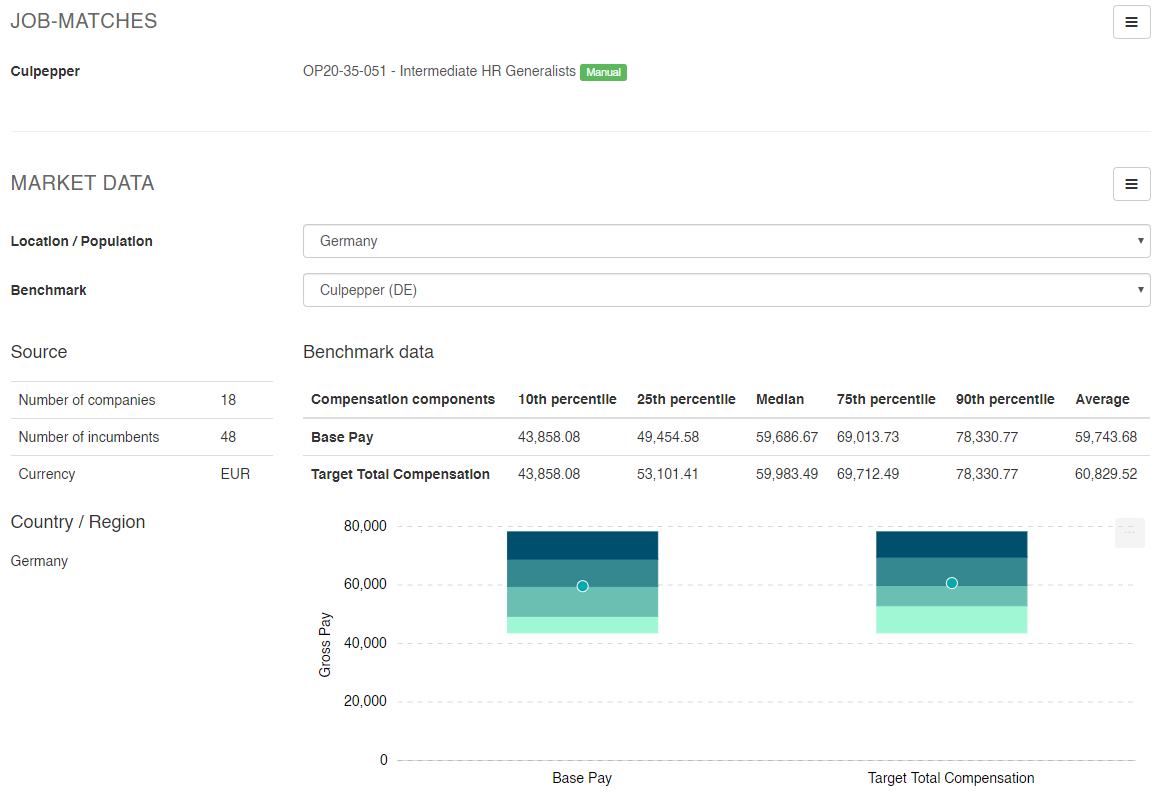A guide to compensation benchmarking
Compensation benchmarking, also known as market pricing, is a systematic approach to collecting and evaluating data on salaries. It compares an organization’s employee pay rates with those of similar jobs in other companies.
The aim is to understand how an organization’s pay rates compare to market rates in order to set individual salaries at an appropriate level and further structure compensation systems.
The concept of market pricing is quite common and is used more regularly in US-American companies where there is a stronger focus on the “price” of a job. European companies tend to focus on the “value” of a job and use this value to design formalized compensation structures such as pay bands and pay groups.
gradar offers an automated translation of its job evaluation results into survey-specific job codes from multiple vendors. We use the information from gradar’s career path and job grade, together with our global job families, to access vendor-specific translation matrices.
career path
Job Evaluation in three
Career Paths
- Individual Contribution
- Project Management
- Management
job grade
Job grading from grade 1 to 25
- Individual Contribution grades 1 - 19
- Project Management grades 10 - 21
- Management grades 11 - 25
global job family
choice of currently
- 24 job families
- 108 subfamilies
benchmark job match
Benchmark survey job matching
Our job matching module is a web-based translation matrix for converting the analytical job evaluation results into benchmark job matches from global and local salary surveys
gradar’s job matching module is a major timesaver for all compensation professionals as you can manage all your jobs and their matches to compensation surveys in our system.
As well as our connections with local partners such as Lurse in Germany, we’ve formed a strong relationship with global data vendor Culpepper, who offer a 20% discount on its products for all gradar users.
Job matches and market data in gradar
Market data from third-party compensation survey providers, such as Culpepper, can be uploaded in gradar. Data for Base Pay and Target Total Compensation is then displayed on the job profiles and as a detailed report. The system uses the benchmark job code from our job matching module to display job specific benchmark data.

What’s in a salary survey?
Although the concept of market benchmarking is quite common, there’s no such thing as an accurate single rate of pay for a job. Market prices may vary between survey vendors within the same occupation and in the same location. The determinants of salary can be sorted into three categories:
Personal characteristics
- Gender
- Age
- Professional experience
- Job tenure
- Education and training
- Capabilities
- IQ
Job characteristics
- Location of employment
- Requirements of the job (a proxy for this are methods of job evaluation)
- Profession, also job family or occupational group
Organizational characteristics
- Sector of operations, e.g. logistics, retail, technology
- Size of the organization, e.g. based on number of employees
Personal characteristics are more of an informative value and should not be used in determining a salary. In fact, every effort should be made to avoid the use of discriminatory practices based on age, gender, ethnic background or sexual orientation.
Reliable salary survey vendors will exclusively take job and organizational characteristics into account to analyze their inputs and prepare their market rates.
Whenever you buy a salary survey, you buy a vendor-specific market benchmark. Some of these benchmarks focus on certain operational sectors such as pharmaceutical or retail companies. Others may have a regional focus on certain metropolitan areas or be targeted at a certain size of organization.
Almost all benchmarks take the location of employment into account by analyzing data separately for every country. It is not mixed on a cross-national level.
Outside of the US, the participant lists often consist of large Anglo-American firms with some regional enterprises and local firms also involved. It means we often see similar results from US-American vendors.
In order to satisfy customer needs, the surveys need to deliver consistent results year-on-year. Data must be edited until it fits the previous year's median results by +/- x %. As a consequence, the results are often not representative of real-life local market conditions, especially in CEE and Emerging Markets. That’s why we recommend to look carefully into the quality and reliability of the pay surveys you intend to use.
How to assess the quality and validity of salary surveys?
It’s important for employers to consider how to interpret the data collected and where the organization wants to position its salary levels in relation to the market.
The data quality of a salary survey is determined mainly by:
- The methodology used for job matching
- The source of compensation data
- The vendor's approach to analyzing and editing the data input
Job matching methodology
Global vendors often use the same job matching methodology and data collection process, making their surveys an attractive choice for firms operating worldwide. Local vendors may use benchmarking approaches tailored to national or regional needs and usually attract more domestic participants.
It therefore makes sense to assess the size of the respective database, its participants and the availability of job specific benchmark data for every country that you are interested in. There is no one-size-fits-all approach.
Collective bargaining agreements are an alternative source for salary comparisons since pay in some markets - especially Europe - is heavily regulated through labour agreements that cover a large employee population.
In a market like Germany, the strongest salary survey databases contain about 500,000 individual data points whereas the labour agreements for the metal and electronic industry alone cover more than 3,500,000 employees. In some cases, this data might be the better fit, at least for non-exempt jobs, and is often accessible at no cost.
gradar aligns strongly with collective bargaining agreements and we’ve captured the correlations in our own compensation survey rosetta stone documentation.
The reliability of the job matching process
Job matching is about identifying benchmark jobs from compensation surveys in order to assess the market price of a position. The validity and reliability of a market benchmark depends on the quality of the job matching between internal and external jobs.
There are four common types of job matching methodologies used today, though some elements may be combined into a unified approach:
- Matching by job title. This approach is most common for vendors that collect data directly from individuals and not from HR and Compensation professionals. As a result, it’s the most unreliable approach and is only feasible with a minimum level of accuracy for very generic jobs or professions such as plumbers or accountants. Some vendors even add personal characteristics such as job tenure or age to the analysis.
- Matching by benchmark job. Vendors use this approach by adding the core duties and responsibilities to a benchmark job profile, though it is fairly uncommon. Different ranks need separate descriptions, which makes this a fairly accurate approach. However, it’s difficult to select a better-fitting match if a higher or lower description does not exist.
- Capsule job descriptions. This is the enhanced version of matching by benchmark job, where a survey vendor would describe the main responsibilities and core duties in much more detail and outline modifiers for lower or higher levels of requirements. This approach is most common in club surveys.
- Job families with a non-analytical job leveling methodology. Most vendors today use this approach, with the quality of the generic job family descriptions satisfactory in most surveys. However, the more sub-families available, the more scattered the job matching and the less reliable the results. The quality of the generic job level descriptions varies a lot between and within surveys. The non-analytical approach is not as accurate as analytical job evaluation results and should not be used for pay equity decisions or as basis for compensation structuring.
Culpepper, our strategic partner, uses a combination of job classifications and levels (Executive, Management, Professional Individual Contributors and Support Individual Contributors) with comprehensive job family descriptions for Executives, Engineering, Health Care, Life Sciences, Operations, Sales and Technology roles.
Accurate job matching is the foundation of salary benchmarks and market comparisons. And matching an internal job to an external benchmark job of similar content is the key to accessing benchmark data from salary surveys. The benchmark data can be used to compare employees' salaries against market rates and may be included in the modelling of pay bands and in the determination of a competitive ratio of base and variable pay.
- gradar automatically suggests benchmark jobs that are likely to be a good fit to the position that you have evaluated.
- gradar is compatible with benchmark jobs from a number of locally and globally recognized publishers where the appropriate surveys for your organization cover relevant industries, jobs and markets.
- gradar enables you to store the job grading and job matching decision online.
Data in compensation surveys
Compensation survey market data is not a representative source of information. There can be no guarantee that conclusions drawn from a certain sample will extend to the population as a whole. Salary reports should always be used with care!
The population of a survey is made up from either the participating companies’ incumbent data, submitted by HR, or direct submissions from employees. It’s constantly changing, so vendors are faced with the challenge to maintain a certain level of consistency in their benchmark salaries over a period of time. To do this, the providers use different approaches to analyze and prepare their salary reports.
Market values from descriptive statistics
This approach represents salary information through percentiles:
- Based on pure data input
Data is collected and described as is. There is no editing of the population or removal of data points. Vendors that follow this approach face volatile results in an annual comparison since the population rarely remains stable. This becomes more of a problem as the population size decreases. - Based on edited data input
Automated computer programs - or human analysts - edit the data by removing ‘outliers’ in order to keep median values relatively stable. A deviation of median values by +/- 5% may be shown over a given period of time.
The latter approach is likely to work well with submissions from HR or Compensation professionals as the vendor’s analyst will have someone to discuss the data with. The vendors who use direct inputs from employees will be fishing in the dark and may have to rely on the statistical analysis alone, without being able to validate the data input.
gradar and Culpepper collect compensation data directly from HR professionals in participating organizations. We combine the power of data analytics with the experience of their Compensation Specialists to ensure that data is both accurate and reliable.
Market values from statistical models
Statistical data is calculated through regression analysis and significance testing to show a possible market salary. This approach is only used in a few surveys.
Market values from experience
Data and experience from candidate interviews are combined to show market salary ranges. This approach is often used by local and global recruiting agencies.
Conclusion on using compensation benchmarking
We recommend using salary comparisons in combination with other sources such as multiple compensation surveys, data from labour agreements, internal employee analysis and analytical job evaluation.
Michael Armstrong’s guide to achieving fairness and transparency in pay and reward provides an in-depth overview on the limitations of market pricing.
Click here to open the Book By clicking, you agree to our Terms and that you have read our Data Use Policy, including our Cookie Use.We recommend ‘Armstrong’s Job Evaluation Handbook’ and ‘Armstrong’s Handbook of Reward Management Practice’ be read by every HR and Compensation professional.
would you like to know more?
register now for our free evaluation version and try gradar for free!





